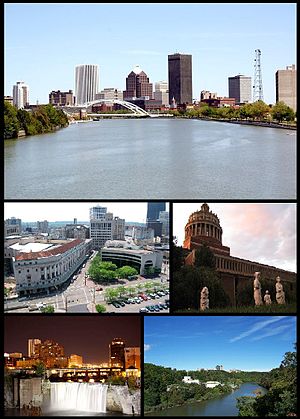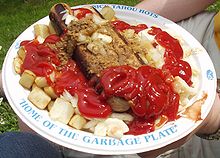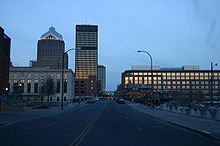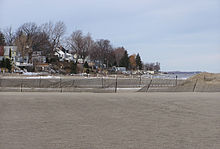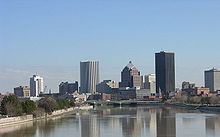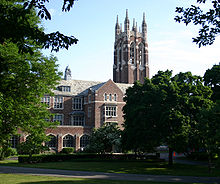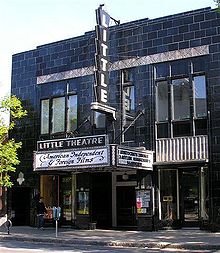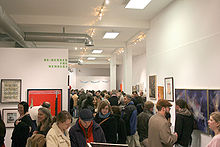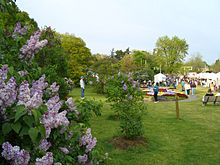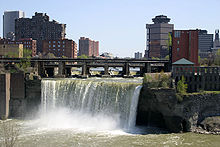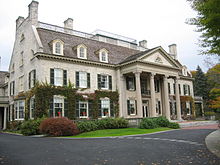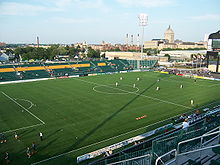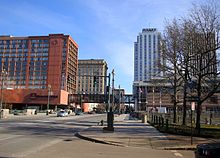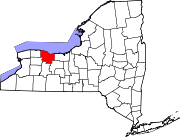- Rochester, New York
-
This article is about the city of Rochester in Monroe County. For the town in Ulster County, see Rochester, Ulster County, New York. For the metropolitan area, see Rochester, New York metropolitan area.
Rochester — City — Images from left to right; Rochester Skyline, The Eastman Theater, the University of Rochester, High Falls district, Eastman Kodak research facility on the Genesee River 
Flag
SealNickname(s): "The Flour City", "The Flower City", "The World's Image Centre" Motto: Rochester: Made for Living Coordinates: 43°9′56″N 77°36′41″W / 43.16556°N 77.61139°W Country United States State New York County Monroe Government[1] – Type Mayor-Council – Mayor Thomas S. Richards (D) – City Council Members' ListArea – City 37.1 sq mi (96.1 km2) – Land 35.8 sq mi (92.8 km2) – Water 1.3 sq mi (3.3 km2) Elevation 505 ft (154 m) Population (2010 Census) – City 210,565 – Density 6,132.9/sq mi (2,368.3/km2) – Urban 694,396 (53rd in U.S.) – Metro 1,098,201 Demonym Rochesterian Time zone EST (UTC-5) – Summer (DST) EDT (UTC-4) ZIP code 146xx (14604=downtown) Area code(s) 585 FIPS code 36-63000 GNIS feature ID 0962684 Website www.cityofrochester.gov Rochester is a city in Monroe County, New York, south of Lake Ontario in the United States. Known as The World's Image Centre,[2] it was also once known as The Flour City, and more recently as The Flower City. It is the county seat for Monroe County.
Rochester's city population according to the 2010 census is approximately 210,565, making it New York's third most populous city after New York City and Buffalo. It is at the center of a larger Metropolitan Area which encompasses and extends beyond Monroe County and includes Genesee County, Livingston County, Ontario County, Orleans County and Wayne County. This area, which is part of the Western New York region, had a population of 1,037,831 people at the time of the 2000 Census. As of April 1, 2010, the 2010 Census indicated that this population rose to 1,054,322 .[3]
Rochester was ranked as the sixth 'most livable city' among 379 U.S. metropolitan areas in the 25th edition (2007) of the Places Rated Almanac.[4][5] The Rochester area also received the top ranking for overall quality of life among U.S. metros with populations of more than 1 million in a 2007 study by Expansion Management magazine.[6][7] In the same study, Expansion Management rated the area's public schools as sixth best nationwide.[8] In 2010 Forbes rated Rochester as the 3rd best place to raise a family.[9]
Rochester is an international center of higher education, as well as medical and technological development. The region is known for many acclaimed universities, and several of them (notably the University of Rochester and the Rochester Institute of Technology) are nationally renowned for their research programs. In addition, Rochester has been and continues to be the site of many important inventions and innovations in consumer products. The Rochester area is currently home to corporations such as Kodak, Bausch & Lomb and Xerox that conduct extensive research and manufacturing in the fields of industrial and consumer products. The Rochester metropolitan area is the second largest regional economy in New York State according to the U.S. Internal Revenue Service, after the New York City metropolitan area.[10]
Founding and early history
Main article: History of Rochester, New York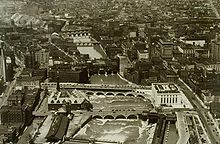 An aerial view of downtown Rochester from 1938
An aerial view of downtown Rochester from 1938
Development of modern Rochester followed the American Revolution, and forced cession of their territory by the Iroquois after the defeat of Great Britain. Allied with the British, four major Iroquois tribes were essentially forced from New York.
On November 8, 1803, Col. Nathaniel Rochester (1752–1831), Maj. Charles Carroll, and Col. William Fitzhugh, Jr. (1761–1839), all of Hagerstown, Maryland, purchased a 100-acre (ca. 40 ha) tract from the state in Western New York along the Genesee River. They chose the site because its three cataracts on the Genesee offered great potential for water power. Beginning in 1811, and with a population of 15, the three founders surveyed the land and laid out streets and tracts. In 1817, the Brown brothers and other landowners joined their lands with the Hundred Acre Tract to form the village of Rochesterville.
 Bridge originally built as an aqueduct for the Erie Canal in 1842, replacing the original construction from 1823. It was subsequently used for subway trains and, in the 1920s, the Broad Street Bridge was erected on top of it. This photograph shows how it appeared in 2002.
Bridge originally built as an aqueduct for the Erie Canal in 1842, replacing the original construction from 1823. It was subsequently used for subway trains and, in the 1920s, the Broad Street Bridge was erected on top of it. This photograph shows how it appeared in 2002.
By 1821, Rochesterville was the seat of Monroe County. In 1823, Rochesterville consisted of 1,012 acres (4 km2) and 2,500 residents, and the Village of Rochesterville became known as Rochester. Also in 1823, the Erie Canal aqueduct over the Genesee River was completed, and the Erie Canal east to the Hudson River was opened. (In the early 20th century, after the advent of railroads, the presence of the canal in the center city was an obstacle; it was re-routed south of Rochester.) By 1830, Rochester's population was 9,200 and in 1834, it was re-chartered as a city.
Rochester was first known as "The Young Lion of the West", and then as the "Flour City". By 1838, Rochester was the largest flour-producing city in the United States. Having doubled its population in only ten years, Rochester became America's first "boomtown".
By the mid-19th century, as the center of the wheat-processing industry moved west with population and agriculture, the city became home to an expanding nursery business, giving rise to the city's second nickname, the "Flower City." Large and small nurseries ringed the city, the most famous of which was started in 1840 by immigrants George Ellwanger from Germany and Patrick Barry from Ireland.[11]
In 1847, Frederick Douglass founded the abolitionist newspaper The North Star in Rochester. Douglass, a former slave and an antislavery speaker and writer, gained a circulation of over 4,000 readers in the United States, Europe and the Caribbean. The North Star served as a forum for abolitionist views. The Douglass home burnt down in 1872, but a marker for it can be found in Highland Park off South Avenue.[12] The city was also home to Susan B. Anthony, an abolitionist who became active in the women's rights movement. At the end of the 19th century, anarchist Emma Goldman lived and worked in Rochester for several years, where she championed the cause of labor in Rochester sweatshops.
After the Civil War, Rochester had an expansion of new industries in the late 19th century, founded by migrants to the city, such as inventor and entrepreneur George Eastman, who founded Eastman Kodak, and German immigrants John Jacob Bausch and Henry Lomb, who combined technical and financial expertise to launch Bausch & Lomb in 1861. Not only did they create new industries and thousands of jobs, but Eastman became a major philanthropist, developing and endowing the University of Rochester, its Eastman School of Music and other local institutions. He also supported the development of the Massachusetts Institute of Technology (MIT) and Tuskegee University in the late 19th and early 20th centuries.
In the early 20th century, Rochester became a center of the garment industry, particularly men's fashions. It was the base of enterprises such as Bond Clothing Stores, Fashion Park Clothes, Hickey Freeman, and Stein-Bloch & Co. The carriage maker James Cunningham and Sons founded a pioneer automobile company - Cunningham.[13]
The population reached 62,386 in 1870, 162,608 in 1900 and 295,750 in 1920. By 1950, the population had reached a high of 332,488. With industrial restructuring in the later 20th century, and the decline of industry and jobs in the area, by 2010, the population had declined to 210,565 in the city, although the metropolitan area was considerably larger.
Geography and climate
Rochester is at 43°9′56″N 77°36′41″W / 43.16556°N 77.61139°W (43.165496, -77.611504).[14] The city is east of Buffalo, west of Syracuse and sits on Lake Ontario's southern shore. The Genesee River bisects the city.
According to the United States Census Bureau, the city has a total area of 37.1 square miles (96 km2), of which 35.8 square miles (93 km2) of it is land and 1.3 square miles (3.4 km2) of it (3.42%) is water.
Rochester's geography was formed by the ice sheets during the Pleistocene epoch. The retreating ice sheets reached a standstill at what is now the southern border of the city, melting at the same rate as they were advancing, depositing sediment along the southern edge of the ice mass. This created a line of hills, including (from west to east) Mt. Hope, the hills of Highland Park, Pinnacle Hill, and Cobb's Hill. Because the sediment of these hills was deposited into a proglacial lake, they are stratified and classified as a "kame delta". A brief retreat and readvance of the ice sheet onto the delta deposited unstratified material there, creating a rare hybrid structure called a "kame moraine".
The ice sheets also created Lake Ontario (one of the five fresh-water Great Lakes), the Genesee River with its waterfalls and gorges, Irondequoit Bay, Sodus Bay, Braddock Bay, Mendon Ponds, numerous local streams and ponds, the Ridge, and the nearby Finger Lakes.
According to the City of Rochester, the city has 537 miles (864 km) of public streets, 585 miles (941 km) of water mains, 44 vehicular and eight pedestrian bridges, 11 public libraries, two police stations (one for the east side, one for the west), and 15 firehouses. The principal source of water is Hemlock Lake, which, with its watershed, is owned by the state of New York. Other water sources include Canadice Lake and Lake Ontario. The 30-year annual average snowfall is 95.0 inches (241 cm).[15][not in citation given] The mean July temperature is 71.3 °F (21.8 °C) and the mean February temperature is 23.6 °F (−4.7 °C). The high amount of snow that Rochester receives can be accounted for by the city's proximity to Lake Ontario (see lake effect).
Rochester lies in the Humid continental climate zone (Köppen Dfb)[16] and has four distinct seasons, with often cold and snowy winters. Autumn features brilliant foliage colors, and summer sees generally comfortable temperatures that usually stay in the 80-85 °F (upper 20s °C) range accompanied by moderate to high humidity. Heatwaves are not uncommon during a typical summer. Precipitation is plentiful year round.
Climate data for Rochester, New York Month Jan Feb Mar Apr May Jun Jul Aug Sep Oct Nov Dec Year Record high °F (°C) 74
(23)73
(23)84
(29)93
(34)94
(34)100
(38)102
(39)99
(37)99
(37)91
(33)81
(27)72
(22)102
(39)Average high °F (°C) 31.2
(−0.4)33.2
(0.7)42.7
(5.9)55.2
(12.9)67.9
(19.9)76.6
(24.8)81.4
(27.4)79.1
(26.2)71.1
(21.7)59.7
(15.4)47.2
(8.4)36.1
(2.3)56.8 Average low °F (°C) 16.6
(−8.6)17.3
(−8.2)25.2
(−3.8)35.3
(1.8)46.1
(7.8)55.0
(12.8)60.0
(15.6)58.7
(14.8)51.3
(10.7)41.1
(5.1)32.6
(0.3)22.7
(−5.2)38.5 Record low °F (°C) −17
(−27)−22
(−30)−7
(−22)13
(−11)26
(−3)35
(2)42
(6)36
(2)28
(−2)20
(−7)5
(−15)−16
(−27)−22
(−30)Precipitation inches (mm) 2.34
(59.4)2.04
(51.8)2.58
(65.5)2.75
(69.9)2.82
(71.6)3.36
(85.3)2.93
(74.4)3.54
(89.9)3.45
(87.6)2.60
(66)2.84
(72.1)2.73
(69.3)33.98
(863.1)Snowfall inches (cm) 22.5
(57.2)22.1
(56.1)16.2
(41.1)5.1
(13).5
(1.3)0
(0)0
(0)0
(0)0
(0).1
(0.3)8.1
(20.6)21.2
(53.8)95.8
(243.3)Avg. precipitation days (≥ 0.01 in) 19.1 16.3 15.2 13.5 11.8 11.6 10.2 10.7 11.8 12.8 15.9 18.4 167.3 Avg. snowy days (≥ 0.1 in) 17.2 14.3 9.8 3.6 .3 0 0 0 0 .3 6.3 14.5 66.3 Sunshine hours 108.5 118.7 176.7 216.0 266.6 297.0 313.1 272.8 213.0 155.0 81.0 77.5 2,295.9 Source no. 1: NOAA[17] Source no. 2: Hong Kong Observatory[18] Demographics
Historical populations Year Pop. ±% 1812* 15 — 1820 1,502 +9913.3% 1830 9,207 +513.0% 1840 20,191 +119.3% 1850 36,403 +80.3% 1860 48,204 +32.4% 1870 62,386 +29.4% 1880 89,366 +43.2% 1890 133,896 +49.8% 1900 162,608 +21.4% 1910 218,149 +34.2% 1920 295,750 +35.6% 1930 328,132 +10.9% 1940 324,975 −1.0% 1950 332,488 +2.3% 1960 318,611 −4.2% 1970 296,233 −7.0% 1980 241,741 −18.4% 1990 231,636 −4.2% 2000 219,773 −5.1% 2010 210,565 −4.2% Population source:[19][20][21] According to the 2010 Census, the city's population was 43.7% White (37.6% non-Hispanic White alone), 41.7% Black or African American (38.8% non-Hispanic Black or African American alone), 0.5% American Indian and Alaska Native, 3.1% Asian, 0.0% Native Hawaiian and Other Pacific Islander, 6.6% from some other race and 4.4% from two or more races. 16.4% of the total population were Hispanic or Latino of any race, mostly made up of Puerto Ricans.[22][23]
In the census[24] of 2000, there were 219,773 people (210,565 counted in the census of 2010),[25] 88,999 households, and 47,169 families residing in the city. The population density was 6,132.9 people per square mile (2,368.3/km²). There were 99,789 housing units at an average density of 2,784.7 per square mile (1,075.3/km²). The racial makeup was 48.30% White, 38.55% African American, 0.47% Native American, 2.25% Asian, 0.05% Pacific Islander, 6.58% from other races, and 3.81% from two or more races. Hispanic or Latino of any race were 12.75% of the population. Ancestries include: German (10.9%), Italian (10.0%), Irish (9.6%), English (5.8%), and Polish (2.7%).[26]
As of 1997, Rochester had the largest per capita deaf population in the United States.[27]
There were 88,999 households of which 30.0% had children under 18 living with them, 25.1% were married couples living together, 23.3% had a female householder with no husband present, and 47.0% were non-families. 37.1% of all households were made up of individuals and 9.2% had someone living alone 65 or older. The average household size was 2.36 and the average family size was 3.19.
Web site ePodunk estimates that Rochester has approximately 60% more gay males and lesbians per capita than the national average.[28]
The city population was 28.1% under 18, 11.6% from 18 to 24, 32.2% from 25 to 44, 18.1% from 45 to 64, and 10.0% who were 65 or older. The median age was 31. For every 100 females there were 91.6 males. For every 100 females 18 and over, there were 87.3 males.
The median income for a city household was $27,123, and the median family income was $31,257. Males had a median income of $30,521, versus $25,139 for females. The per capita income for the city was $15,588. About 23.4% of families and 25.9% of the population were below the poverty line, including 37.5% of those under age 18 and 15.4% of those age 65 or over.
Crime
In 2006 Rochester had 1259.6 reported violent crimes per 100,000 residents, compared to a national rate of 553.5.[29] For 2006, Rochester had 827 personal crime incidents per 100,000 and 7,173 property crime incidents per 100,000.
With 100 being the national average, Rochester scores the following:
Personal Crime Risk - 170 Property Crime Risk - 134[30]
In 2008, Rochester reported 42 murders (20.5 per 100,000 people), 98 sexual assaults, 1,059 robberies, 1,103 assaults, 2,808 burglaries, 7,060 larceny thefts, and 1,262 auto thefts.[31]
Economy
Rochester is home to a number of international businesses, including Fortune 1000 company Eastman Kodak, as well as several national and regional companies, such as Bausch and Lomb. Xerox was founded in Rochester in 1906 as The Haloid Company,[32] and retains a significant presence in Rochester, although its headquarters are now located in Norwalk, Connecticut. The Gannett newspaper company and Western Union were founded in the Rochester area by Frank Gannett and Hiram Sibley respectively but have since moved to other cities.
Because of the high prevalence of imaging and optical science among the industry and the universities, Rochester is known as the world capital of imaging. The Institute of Optics of the University of Rochester and the Rochester Institute of Technology in nearby Henrietta both have imaging programs.[33] In 2006, the University of Rochester became the largest employer in the Rochester area, surpassing Kodak.[34]
Food and beverage
One food product that Rochester calls its own is the "white hot", a variant of the hot dog made by the local Zweigle's company and other companies. Another local specialty is the "garbage plate," first served at Nick Tahou Hots and traditionally includes cube fries, mac salad, meat sauce, onions, mustard and choice of hot dog or hamburger. Many area restaurants feature copies or variations of the "garbage plate" but cannot call it such because of trademarks. Instead the term "plate" is used to indicate it as such. Rochester was home to French's Mustard, whose address was 1 Mustard Street.
Genesee Brewing Company, maker of the Genesee beers, Honey Brown, Dundee Ales & Lagers and Labatt Blue Lime also calls Rochester home.
The Ragú brand of pasta sauce was originally produced in Rochester.
Other local franchises include: Bill Gray's (a hamburger/hot dog joint that lays claim to having "The World's Greatest Cheeseburger"), Country Sweet (known for their chicken wings and BBQ sauce), Boss Sauce, described as a "tantalizing sweet, spicy-hot gourmet after-sauce," was born from the restaurant Eddie's Chicken Coop, Tom Wahl's, DiBella's and Abbott's Frozen Custard. Dinosaur Bar-b-que, which originated in Syracuse, also operates their second franchise downtown in the former Lehigh Valley Railroad station on the Genesee River.
Major shopping centers
- Rochester Public Market
- The Mall at Greece Ridge
- The Marketplace Mall
- Eastview Mall
- Village Gate Square
Former shopping centers
- Midtown Plaza (Closed as of July 29, 2008)
Tallest structures
Main article: List of tallest buildings in Rochester, New YorkAs of February 2008, the top ten tallest buildings in the city are:[35]
Building name Height ft m Xerox Tower 443 135 Bausch & Lomb Place 401 122 Chase Tower 392 119 Kodak Tower 360 110 First Federal Plaza 309 94 One HSBC Plaza 284 87 Hyatt Regency Hotel 271 83 Times Square Building 260 79 Midtown Tower 251 77 St. Michael's Church 246 75 Companies
Several companies have corporate headquarters in Rochester.
- Abbott's Frozen Custard - Ice cream franchise
- Ambrosia Software - Software firm
- Bausch & Lomb - Contact lens care & eye health
- Carestream Health - Health equipment and technology
- Eastman Kodak - Photography and Printing
- ESL Federal Credit Union - New York State's largest credit union in assets[36]
- Genesee Brewing Company - Brewery
- Gleason Corporation - Gear equipment manufacturer
- Hickey Freeman - handmade suits and clothing, including the Bobby Jones line
- Home Properties - Apartment and Properties firm
- Monro Muffler Brake - Auto care chain
- North American Breweries - Alcoholic beverage company
- Rochester Midland Corporation - Chemical manufacturing
- Rohrbach Brewing Company - Microbrewery
- Wegmans Food Markets - Grocery
Locally founded corporations that have since moved their headquarters to other states include French's, Gannett, Western Union, Champion and Xerox. Humor website eBaum's World was also started in Rochester. Companies that moved their headquarters from the city of Rochester to the suburbs include Wegmans (Gates, NY) and Paychex (Penfield, NY).[37][38]
Government
Rochester is governed by a "strong mayor" serving as chief executive of city government and a city council consisting of 4 district members and 5 at-large members.[39] Mayor Thomas Richards, a Democrat, was elected in a special city-wide election on March 29, 2011 after the two-term elected mayor, Robert Duffy was elected Lieutenant Governor of New York State in November 2010.
The city's police department is the Rochester Police Department, currently headed by Chief of Police James Sheppard.
Neighborhood Empowerment Team
Enforcement of property code violations in Rochester is handled by the Neighborhood Empowerment Team, or NET. Rather than utilizing a centralized code enforcement office, each neighborhood in Rochester is assigned its own NET office. Some have complained about the lack of consistency in the resulting manner and severity of enforcement. On July 16, 2008, the city announced that two of the NET offices would be closed and another relocated, due to what it had found to be the high cost and low value of operating the decentralized network.[40]
Cityscape
Principal suburbs
Suburbs of the city include: Brighton, Brockport, Chili, Churchville, East Rochester, Fairport, Gates, Greece, Hamlin, Henrietta, Hilton, Irondequoit, Mendon, Ogden, Parma, Penfield, Pittsford, Riga, Rush, Scottsville, Spencerport, Webster, Victor and Wheatland.
Neighborhoods
Rochester has a number of neighborhoods, including the 19th Ward [4], 14621 Community [5], Beechwood [6], Browncroft [7], Cascade District, Cobbs Hill, Charlotte, Corn Hill [8], Dewey, Dutchtown, Edgerton, Ellwanger-Barry, German Village, Grove Place [9], High Falls District, Highland park [10], Lyell-Otis, Dutchtown Maplewood [11](10th ward), Marketview Heights [12], Mt. Read, Northern edge [13], Otis-Lyell [14], Park Avenue, Plymouth-Exchange, Southwest, East End, South Wedge, Swillburg [15], Susan B. Anthony [16], University-Atlantic, Upper Monroe [17], and more are all recognized communities with various neighborhood associations. There are also living spaces in Downtown Rochester.
Browncroft
The Browncroft neighborhood is built on the former nursery grounds of the Brown Brothers nursery. The business district situated on Winton Rd has a mix of restaurants and shops. The neighborhood borders the nearby Tryon and Ellison Parks. The Browncroft Historic District was listed on the National Register of Historic Places in 2004.[41]
14621 community
Extending across much of the north-central cityscape of Rochester, now including parts of the old Hudson Avenue and North Clinton neighborhoods, is the 14621 community. Today this neighborhood is predominantly African American and Hispanic, this community suffered being the center of the 1964 riots.[42][43] The riots did produce some benefits in the long run: the north-central area has been the site of ongoing urban renewal projects since the late 1960s, and, as noted by "JULY ’64" filmmakers Carvin Eison and Chris Christopher, inspired the developent of such important African American organizations such as The Urban League of Rochester as well as Rochester’s first anti-poverty organization (Action for a Better Community), and black community activist organization Freedom, Integration, God, Honor, Today (F.I.G.H.T.). (F.I.G.H.T.) was founded by Rev. Franklin Florence and Deleon McEwen, who would become the first president of (F.I.G.H.T). The establishment of this program came the assistance of Saul Alinsky. However, the neighborhood is still considered the most dangerous part of Rochester and is blighted by crime, drugs and gang activity.[44]
Lyell Avenue
Once an Italian-American neighborhood, there have recently been efforts by to improve the quality of life in this neighborhood. It is known largely for its crime, especially instances of prostitution and drug sales.
19th Ward
The 19th Ward is a southwest neighborhood bordered by Genesee Street, West Avenue, the Erie Canal, and is across the river from the University of Rochester.[45] Now known by its slogan "Urban by Choice," in the early 19th century the area was known as Castle Town, after Castle Inn, a tavern run by Colonel Isaac Castle. By the early 1820s however, the area became overshadowed by developments in the north that would later become downtown Rochester. Due to a tumultuous bend in the Genesee river, the area was home to skilled boatsmen that assisted boats traveling north to Rochester and the area was consequently known during this time as "The Rapids". In the 1890s, as Rochester expanded, the area became a prosperous residential area that thrived as the city grew. By 1930 it was a booming residential area for doctors, lawyers, and skilled workers; it includes the still prestigious Sibley Tract development. Homes in the originally upper-class neighborhood typically have gumwood trim, leaded glass, fireplaces, hardwood floors, and open porches. In the 1960s, property values declined as the population of Rochester did, the area experienced white flight accelerated by school busing, blockbusting, and race riots downtown, and crime increased, with violence, drug use, and neglected property further diminishing property values.[46]
The 19th Ward has had an active community association since 1965, and is known for its ethnic, class, and cultural diversity.[vague] The current "Brooks Landing" development is successfully bringing new economic development to the community including an 88-room hotel, 20,000-square-foot (1,900 m2) office building, 11,000 square feet (1,000 m2) of new retail, and Boulder Coffee shop.[47]
Charlotte
Charlotte (shar-LOT) is a lake front community in Rochester bordering Lake Ontario. It is home to Ontario Beach Park, commonly known as Charlotte Beach, which is a popular summer destination for Rochesterians. A new terminal was built in 2004 for the Rochester-to-Toronto ferry service and was later sold after the ferry ceased operations in 2005. The Port of Rochester terminal still exists and has since been completely revamped. It now houses a popular high-end restaurant and event facility—Pier 45 at The Port, the restaurant Cheeburger Cheeburger, the restaurant California Rollin', a coffee shop named The Nutty Bavarian, and an Abbott's Frozen Custard.
Corn Hill
The Corn Hill neighborhood near downtown is one of the nation's best preserved Victorian neighborhoods and a center for art. It is also home to Corn Hill Landing, a shopping and housing strip located on the Genesee River. The annual Corn Hill Art Festival, a two day event held the weekend after the 4th of July, is one of the city's most popular gatherings for art display.
Upper Monroe
Located less than one and one-half miles from downtown, Upper Monroe encompasses 17 streets with 1400 households and approximately 3300 residents. Cobbs Hill Park, with its beautiful reservoir, tennis courts and athletic fields, forms the southeastern boundary of this neighborhood. Highland Park, world-renowned for its annual Lilac Festival, also is within walking distance.[48] The Upper Monroe Neighborhood Association (UMNA) is a not-for-profit advocacy group representing the residents and property owners of the Upper Monroe neighborhood. Their goals are to ascertain the needs and concerns of the neighborhood and take positive action to address those needs and concerns.[49] The neighborhood is also home to a number of small, local businesses including: Hardpact, Huey's Hair Company, Monty's Krown, Jeremiah's Tavern, and Park Ave. Pets.[50]
East End
The East End is a residential neighborhood in Downtown Rochester but also the main nightlife district. The Eastman Theatre and the Eastman School of Music are in the East End, along with the Little Theatre, an independent film theatre and many clubs, bars and high-end restaurants.
Maplewood
Maplewood is a northwest neighborhood located south of Eastman Business Park and between the Genesee River and Dewey Avenue. Much of the area's charm comes from the use of parkways as well as parks and greenspace bordering the river. These features are the result of plans designed by Frederick Law Olmsted. The Maplewood Rose Garden is the second largest Rose Test Garden in the United States. The Maplewood Historic District was listed on the National Register of Historic Places in 1997.[41]
Park Avenue and the Neighborhood of the Arts
Lining the streets of Park Avenue are cafes, shops, pubs and restaurants. In a broader view, the total area surrounding University Avenue—known as the Neighborhood of the Arts—is one of the most culture and art-rich sections of the city. Located here are the Village Gate, Memorial Art Gallery, Rochester Museum and Science Center, Rochester Public Market, ARTWalk, George Eastman House, and high-end residential streets such as Granger Place, East Boulevard, Douglas Road, Westminster Road, and Berkeley Street.
Plymouth-Exchange
Also known by the abbreviation PLEX, the Plymouth-Exchange neighborhood provides affordable housing for lower income families. Also home to many University of Rochester students, both grad and undergrad, it has a richly knit community and an active neighborhood association.
South Wedge
The South Wedge neighborhood dates back to 1827, prior to the incorporation of Rochester as a city.[51] The area is bordered by Byron street in the north, South Clinton avenue and Interstate 490 on its east, Highland Park on its south, and The Genesee River on the west. Construction of the Erie Canal (the old canal bed which went by the neighborhood is now used by Interstate 490) brought workers to the area, who set up camps for the months that it took to complete this section of the canal.[52] This racially integrated[citation needed] neighborhood is one of the neighborhoods in Rochester currently undergoing the process of gentrification, partially due to a recent increase in homeownership in the area.[53][54] A lot of young people live in this area.[citation needed] The Linden-South Historic District in South Wedge was listed on the National Register of Historic Places in 2009.[55]
Susan B. Anthony Neighborhood
This neighborhood is a Preservation District on the National Register of Historic Places, known as the Madison Square-West Main Street Historic District.[56] It encompasses a three-and-one-half block area within walking distance from downtown Rochester, and comprises residential, commercial and industrial buildings. The center of the residential area is Susan B. Anthony Square, a 0.84-acre (3,400 m2) park shown on city maps from 1839, which was designed by the famous Olmstead Brothers. Also within the neighborhood is the Susan B. Anthony House, which was the suffragist’s residence for the last decades of her life, now a museum, as well as the Cunningham Carriage factory built in 1848 on Canal Street. James Cunningham Son & Co. sold more carriages in the United States in the 1880s than all other manufacturers combined. The Canal Street property, which still stands, remained Cunningham's headquarters for more than 100 years.
Swillburg
This wedge-shaped piece of the city is bordered by S. Clinton Avenue, Field St, and Interstate 490.[57] The neighborhood received its moniker when a 19th century Rochester pig farmer utilized the area to collect swill for his swine. The neighborhood association humorously honors its roots by using street signs featuring the Swillburg Pig. The area has one of the highest rates of homeownership in the city and is currently undergoing gentrification as well.[citation needed]
The local elementary school is #35, Field Street, which often sponsors a community garden in its courtyard on Pinnacle Street.
Marketview Heights
Running east from Union Street just north of Main Street, Marketview Heights is best known as the location of the Public Market, which offers a variety of groceries and other goods from marketeers from farms and shops from surrounding areas, primarily on the week-ends.
Homestead Heights
Homestead Heights is located in north-east Rochester. It is bordered on the west by Goodman Street, on the north by Clifford Avenue, on the south by Bay Street, and on the east by Culver Road, which is also the border between the city and the town of Irondequoit. The neighborhood is a mix of residential and commercial. Real estate values are higher on the eastern end of the neighborhood near the Irondequoit border. The neighborhood is approximately 2–21⁄4 miles west of the Irondequoit Bay.
Education
The City of Rochester is served by the Rochester City School District which encompasses all public primary and secondary education. The district is governed by a popularly elected seven-member Board of Education. There are also parochial and private primary and secondary schools located within the city. Rochester City Schools consistently post below-average results when compared to the rest of New York State, although on-time graduation rates have improved significantly during the past three years.[58]
Colleges and universities
There are four institutions of higher learning within the city limits of Rochester:
- Colgate Rochester Crozer Divinity School
- Monroe Community College Damon City Campus
- St. Bernard's School of Theology and Ministry
- University of Rochester (including the Eastman School of Music)
Roberts Wesleyan College also located in Rochester is just eight miles (13 km) west of downtown. Additionally, St. John Fisher College and Nazareth College (New York) are located in the nearby suburb of Pittsford.
The Rochester Institute of Technology (RIT) was founded in 1829 in Rochester but moved to Henrietta in 1968.[59]
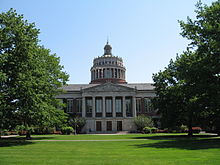 River Campus of the University of Rochester
River Campus of the University of Rochester
University of Rochester
The University of Rochester (U of R), was ranked as the 37th-best university in the nation by U.S. News & World Report for 2011[60] and was deemed "one of the new Ivies" by Newsweek.[61] The nursing school has received many awards and honors[62] and the Simon School of Business is also ranked in the top 30 in many categories.[63]
The university is also home to the Eastman School of Music, which was ranked the number one music school in America. It was founded and endowed by George Eastman in his years as a philanthropist.[64] He also contributed greatly to the University of Rochester from wealth based on the success of Eastman Kodak.
Culture and recreation
The city of Rochester is home to numerous cultural institutions. These include the Garth Fagan Dance, the Rochester Philharmonic Orchestra, George Eastman House International Museum of Photography and Film, Memorial Art Gallery, Rochester Contemporary Art Center, Rochester Museum & Science Center, Strong National Museum of Play, the Strasenburgh Planetarium, Hochstein School of Music and Dance, and numerous arts organizations. Geva Theatre Center is the city's largest professional theatre.
Nightlife
Rochester's East End district, located downtown, is well known as the center of the city's nightlife. It is the stopping point for East Avenue, which along with the surrounding streets is crowded with nightclubs, lounges, coffee shops, bars, and high-end restaurants. The Eastman School of Music, one of the top musical institutes in the nation, and its auditorium are also located within the neighborhood. The Eastman Theatre now plays host to the Rochester Philharmonic Orchestra and other musical/drama events.
There are other, smaller enclaves of after-hours activity scattered across the city. Southeast is the heart of Rochester's thriving arts scene, particularly in and around the Park Avenue neighborhood (which is known for its many coffee shops, cafes, bistros and boutique shopes). Nearby on University Avenue can be found several plazas like the Village Gate which give space to trendy bars, restaurants and art galleries that stay open late into the night. Monroe Avenue, several streets over, is packed with pubs, small restaurants, smoke shops, theaters and several clubs as well as cigar bars and hookah lounges. All of these neighborhoods are home to many artists, musicians, students and Rochester's large LGBT community.
The South Wedge district, located directly below downtown, has seen significant gentrification in recent years and now is the site of many trendy cafes and bars that serve the student community attending the University of Rochester several blocks away from the heart of the neighborhoods. The wedge is quickly becoming one of the most vibrant areas within the city limits, its numerous nightspots keeping the streets busy with college students and young professionals (many of whom live there due to the abundance of affordable housing, thriving nightlife and proximity to many of the region's major hospitals, parks and colleges)
Park lands
 Lamberton Conservatory from 1911 in the Highland Park
Lamberton Conservatory from 1911 in the Highland Park
Rochester is known for its parks, including Highland, Cobb's Hill, Durand-Eastman, Genesee Valley, Maplewood, Edgerton, Seneca, and Ontario Beach; four of these were designed by famed landscape architect Frederick Law Olmsted.[65] The city's Victorian-era Mt. Hope Cemetery includes the final resting places of Susan B. Anthony, Frederick Douglass, and George B. Selden. Other scenic sites are Holy Sepulchre and neighboring Riverside Cemetery.
The city has 13 full-time recreation centers, 19 swimming programs, 3 artificial ice rinks, 66 softball/baseball fields, 47 tennis courts, 5 football fields, 7 soccer fields, and 43 outdoor basketball courts. As a legacy of its time as "The Flower City", Rochester hosts a Lilac Festival for ten days every May, when nearly 400 varieties of lilacs bloom, and 100,000 visitors arrive.
Festivals
The Lilac Festival
Rochester has many festivals in late spring and summer, including the Rochester International Jazz Festival established in 2002, the Corn Hill Festival[66] (arts, crafts, and food in this Third Ward neighborhood), the Rochester-High Falls International Film Festival held at the George Eastman House's Dryden Theatre and the Little Theatre downtown), ImageOut, The Rochester Lesbian & Gay Film & Video Festival held at the Little Theatre, Clothesline Art Festival (artists from the region display their works on the grounds of the Memorial Art Gallery), Park Avenue Merchants Festival, Lilac Festival at Highland Park, St. Patrick's Day parade (March), Rose Festival at Maplewood Park, Irish festival (September), two Greek festivals - one on East Avenue (in June) and one on South Avenue (in September), Gay Pride Festival (July), Puerto Rican Festival(August), Rochester Music Festival, and the Cold Rush Winter Celebration (celebrating winter sports in the Rochester area). In the summer, especially on the Fourth of July, downtown after dark is lit with fireworks and a laser show at the High Falls venue. The most popular of these is undoubtably the Lilac Festival, which attracts many from areas outside of Rochester and draws on average 500,000 people every year.
Media
The Democrat and Chronicle is Rochester's main daily newspaper. The Daily Record, a legal, real estate and business daily, has published Monday through Friday since 1908. Insider magazine (owned by the Democrat and Chronicle), "City" newspaper and the "Freetime" entertainment magazine are free, weekly publications. Rochester Business Journal is the weekly business paper of record. "The Good Life Magazine" is a free bi-monthly publication. There is also a grassroots, democratically run, Independent Media Center called Rochester Indymedia. Media addressing the needs of Rochester's large African American population include "About... time",[67] and "Minority Report",[68] which has an associated news journal for the area's Latin American population, "La Voz".[69]
Rochester has eight broadcast television stations:
- CBS: WROC 8 (cable 8)
- NBC: WHEC 10 (cable 10)
- ABC: WHAM 13 (cable 13)
- PBS: WXXI 21 (cable 11)
- Fox: WUHF 31 (cable 7)
- MyNetworkTV: WBGT 40/26 (cable 18)
- CW CW-WHAM (13-2) (cable 16)
- Rochester Community TV (RCTV cable 15)
Rochester has multiple AM and FM radio stations including WXXI (Public Radio; AM News and Talk, FM Classical and Fine Arts), WCMF (Rock and Roll), WBEE (Country), WPXY (Contemporary Hit Radio), WLGZ (Classic Hits), WROC (Sports), WRMM (Adult Contemporary), WDKX (Urban Contemporary Radio), WJZR (smooth jazz), WBER (alternative, independent, and local), WRUR (adult album alternative), WZNE (modern rock), and WHAM (News and Talk Radio), among others.
Time Warner Cable provides Rochester with cable-fed internet service, digital and standard cable television, and YNN Rochester, a 24-hour local news channel.
Former newspapers
Rochester was served by the Rochester Post Express published by the Post Express Print Company from 1882 to 1923.[70] In 1923 the paper merged with the Rochester News Corporation's Rochester Evening Journal[71] to become Rochester Evening Journal and The Post Express and served the area from 1923 through 1937.[72]
Rochester's evening paper for many years was the Times-Union, which merged operations with the Democrat and Chronicle in 1992, going defunct five years later.
Points of interest
The George Eastman House International Museum of Photography and Film, the World's oldest photography museum
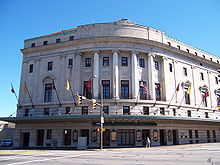 The Eastman Theatre
The Eastman Theatre
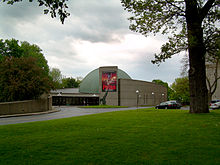 Strasenburgh Planetarium, Rochester Museum & Science Center
Strasenburgh Planetarium, Rochester Museum & Science Center
- Blue Cross Arena at the War Memorial
- Cobbs Hill Park and Reservoir
- Eastman Business Park
- Ellwanger Garden
- Frederick Douglass Monument
- Frontier Field
- George Eastman House
- Geva Theatre Center
- High Falls and the High Falls Entertainment District
- Highland Park
- Liberty Pole
- Little Theatre, one of the oldest art-house movie theaters in the country
- Maplewood Park Rose Garden
- Midtown Plaza, the nation's first downtown shopping mall
- Mount Hope Cemetery, Rochester, the nation's first Victorian cemetery
- Nick Tahou Hots featuring the Garbage Plate and a charity run in its name
- Ontario Beach Park and the Port of Rochester at Charlotte
- The Public Market
- The Rochester Auditorium
- Rochester Contemporary Art Center
- Rochester Riverside Convention Center
- St. Joseph's Church and Rectory (Rochester, New York)
- Seneca Park Zoo, one of the top three family attractions in the area
- Strong National Museum of Play, nation's second-largest children's museum housing the National Toy Hall of Fame
- Strasenburgh Planetarium, part of the Rochester Museum & Science Center
- Susan B. Anthony House
- Times Square Building, noted for its "Wings of Victory" statue.
- University Avenue and Park Avenue Artistic Districts
- University of Rochester
- University of Rochester Arboretum
- University of Rochester's Eastman School of Music and Eastman Theatre
- Water Street Music Hall
Sports
Rochester was named the top minor league sports market in the country by Street & Smith's Sports Business Journal in July 2005, the number 10 "best golf city" in America by Golf Magazine in 2007,[73] and the fifth-best "sports town" in the country by Scarborough Research in September 2008.[74]
Professional sports
Although Rochester is home territory to the Buffalo Bills and the Buffalo Sabres, Rochester has several professional sports teams of its own:[75]
Club Sport Began play League Venue League championships Championship years Rochester Red Wings Baseball 1899 International League Frontier Field 20 1899, 1901, 1909, 1910, 1911, 1928, 1929, 1930, 1931, 1939, 1940, 1952, 1955, 1956, 1964, 1971, 1974, 1988, 1990, 1997 Rochester Americans Ice hockey 1956 AHL Blue Cross Arena 6 1964-65, 1965–66, 1967–68, 1982–83, 1986–87, 1995–96 Rochester Knighthawks Indoor lacrosse 1995 NLL Blue Cross Arena 2 1997, 2007 Rochester Rhinos Soccer 1996 USL Pro Sahlen's Stadium 3 1998, 2000, 2001 Rochester Rattlers Outdoor lacrosse 2001
(2011)MLL Sahlen's Stadium 1 2008 Rochester Razorsharks Basketball 2005 PBL Blue Cross Arena 4 2005-06, 2008, 2009, 2011 Rochester Raiders Indoor football 2006 IFL Dome Arena (Henrietta) 2 2007, 2008 Western New York Flash Soccer 2011 WPS Sahlen's Stadium 1 2011 Rochester Lancers Indoor soccer 2011 MISL Blue Cross Arena Among cities in North America with at least seven current professional teams, Rochester was determined in 2007 to be the only one whose teams all had cumulative winning regular season records.[76]
The Rochester Red Wings baseball club, the AAA affiliate of the Minnesota Twins, play in the International League. The Rochester Americans ice hockey team, the AHL affiliate for the NHL Buffalo Sabres, are known as the "Amerks". The Rochester Rhinos soccer club have played for many years in the USL First Division, which is the second-highest level American soccer league.
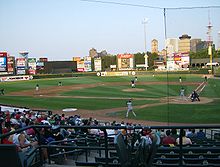 Frontier Field, including the Rochester skyline to the southeast.
Frontier Field, including the Rochester skyline to the southeast.
Lacrosse has seen some popularity in Rochester. The Rochester Knighthawks play box lacrosse in the National Lacrosse League during winter and spring. In outdoor lacrosse, the Rochester Rattlers were a charter member of Major League Lacrosse, but the franchise was transferred to the new Toronto Nationals (MLL) in 2009; the Rattlers will be re-established in 2011 with the transfer of the Chicago Machine franchise. Also during the summer months, the Rochester Greywolves, comprising mostly local talent, play box lacrosse in the semi-pro CanAm Lacrosse League.
Two newer but very successful teams are the Rochester Razorsharks (of the Premier Basketball League) and Rochester Raiders (Indoor Football League); both have dominated their competition, despite some instability in their leagues, and both have championship trophies already. There is also an ownership group looking into bringing indoor soccer to Rochester starting in 2011.
In women's sports, Rochester is the home of the Western New York Flash in Women's Professional Soccer. In prior years, the Rochester Ravens have competed in the semi-pro W-League under a few different names. The Filarets was a notable women's basketball team that played in the 1930s, 1940s and 1950s.
The city also has an independent pro-wrestling league: NWA Upstate.
USA Cycling has an annual tour stop in Rochester; the Rochester Omnium is newly expanded to a three-day professional cycling event featuring the Rochester Twilight Criterium.
The absence of a major pro sports team has not always been the case. From 1920 to 1925, Rochester was home to the Rochester Jeffersons, a charter member of the National Football League. From 1948 to 1957, the Rochester Royals played in the National Basketball Association, winning the NBA championship in 1951. In soccer, the Rochester Lancers played from 1970 to 1980 in the top-level North American Soccer League and became NASL champions in the 1970 season.
Since 1877, 29 teams in eight professional sports have represented Rochester, according to The Rochester Sports Project by local sports historian Douglas Brei. In spring 2006, Brei showed that Rochester's professional sports teams were collectively approaching 25,000 games played. That game was played on June 16, 2006, when Red Wings hosted the Indianapolis Indians at Frontier Field. He also reports that only six active franchises in the history of North American professional sports have played in the same city and same league continuously and uninterrupted since the 19th century: Chicago Cubs, Cincinnati Reds, Philadelphia Phillies, Pittsburgh Pirates, St. Louis Cardinals, and Rochester Red Wings.
College sports
Almost all area college sports are played at the NCAA Division III level. The exception is the RIT men's ice hockey team, which moved up to the Division I level in 2005, and made it to the NCAA Frozen Four in 2010.
Among junior colleges, MCC is dominant[peacock term] in NJCAA Division II sports. They are also a D-III golf powerhouse and in addition won back to back national championships for women's lacrosse in '10 and '11.[peacock term].
Rochester is the largest Metropolitan Statistical Area in the U.S. which does not include at least one college or university participating at the NCAA Division I level in all sports.
Club Sports
Rochester is home to two men's rugby teams, the Rochester Aardvarks and the Rochester Colonials. Both have long histories, with the Aardvarks celebrating their 40th anniversary in 2006, and the Rochester Colonials celebrating 30 years upcoming in 2010. The Aardvarks are one of the few rugby teams in the country to own its own pitch: Aardvark Park in Henrietta, New York, while the Colonials play their matches in the downtown located soccer stadium. The Aardvarks and the Colonials both have hosted local and state-wide tournaments and the Rochester Colonials hosted the 2007 USA Rugby National Collegiate All-Star Championships, Rochester's first national tournament, as well as the 2009 NYS Rugby Upstates Tournament and the 2009 New York State High School Rugby Championships. Both teams participate in the annual Can-Am Rugby Tournament in Saranac Lake, New York in early August. Rochester also has a Women's Rugby club, the Rochester Renegades, who celebrated their 20th anniversary in 2008. The Renegades started the New York State Rugby Women's Division.[citation needed][77]
The Rochester Bicycling Club is a social and fitness bicycling club.[78]
Rochester is also home to Rochester Rhythm the three time champions of the American Extreme Paintball League or AXBL.[citation needed]
The Rochester, NY Region EWGA chapter, homepage [18], organizes leagues, golf training, and golf events and networking for the area's amateur women golfers.
Monroe County supports two adult baseball (hardball) leagues - the Rochester chapters of the Men's Senior Baseball League (MSBL) and National Adult Baseball Association (NABA).
Transportation
 Barges on the Genesee River
Barges on the Genesee River
Maritime transport
There is marine freight service at the Port of Rochester on Lake Ontario, which is connected to the Atlantic Ocean via the Saint Lawrence Seaway.
A short-lived, high-speed passenger/vehicle ferry Spirit of Ontario I, nicknamed The Breeze or The Fast Ferry, linked Rochester to Toronto, Ontario across Lake Ontario. It operated between June 17, 2004, and December 12, 2005, and cost the city $42.5 million. It was sold to Förde Reederei Seetouristik, a German company, for $30 million.
Air transport
Rochester is served by the Greater Rochester International Airport. Daily scheduled air service is provided by Air Canada, AirTran, American, Continental, Delta, JetBlue, United, and US Airways. Many of these airlines do not operate mainline service to Rochester; rather, they contract regional airlines to operate flights on their own, smaller aircraft.
In 2010, the GRIA was ranked the 14th-least expensive airport in the United States by Cheapflights.[79] This was considered a major achievement for the county and the airport authority; as recently as 2003, Rochester's ticket prices were among the highest in the country, ranking as high as fourth in 1999.[80][81]
FedEx founder, Fred Smith, has stated in numerous articles that Xerox Corporation's development of the copier and their need to quickly get parts to customers, was one of the economic issues that lead him to pioneer the overnight delivery business 1971.[citation needed] Due to the fact that Xerox manufactured their copiers in Rochester[citation needed], the city was one of the original 25 cities that Federal Express serviced on their first night of operations on April 17, 1973.[82]
Mass transit
See also: Rochester (Amtrak station)Amtrak (passenger) and freight lines provide rail service to Rochester. Rochester has intercity and transcontinental bus service via Greyhound and Trailways.
Local bus service in Rochester and its county suburbs is provided by the Rochester-Genesee Regional Transportation Authority (RGRTA) via its Regional Transit Service (RTS) subsidiary. RTS also provides suburban service outside the immediate Rochester area and runs smaller transportation systems in outlying counties, such as WATS (Wayne Area Transportation System).
From 1927 to 1957, Rochester had a light rail underground transit system called the Rochester Subway. It was the smallest city in the world to have one. Over the years there have been privately sponsored proposals put forth that encourage the region to support a new system, possibly using some of the old tunnels. One includes converting the Broad Street bridge tunnel—the former canal aqueduct—into an enhanced pedestrian corridor, which would also could include a Rochester Transportation Museum, and a tram system.
The former canal and subway tunnels have become a frequent source of debate. Several city homeless use the tunnels for shelter, and a few areas near tunnel entrances have gained the reputation as being dangerous. The city has considered multiple solutions for the space including recreating a canal way, putting the subway system back in or filling the tunnels entirely. The plan to fill the tunnels in completely has generated criticism as the cost of filling would not generate nor leverage economic development.
Public support continues to grow for re-watering the original Erie Canal through downtown Rochester.[citation needed] In support of the re-watering efforts, the City released a master plan in 2009 calling for the creation of Rochester's Historic Canal District. A subsequent environmental review documment is set to be released in the near future, seeking additional public input. This district includes both private and public investment that builds upon the rich heritage of the district, educational opportuniites, historic interpretation, architectural significant building and recreational amenities. The City is currently seeking public funds for implementing the first of three major phases of the Canal District.
Major highways and roads that serve the Greater Rochester Area
There are three exits off the New York State Thruway (Interstate 90) that serve Rochester. Rochester has an extensive system of contrtolled-access highways (called 'freeways' and 'expresssways') which connects all parts of the city and the Thruway. During the Thruway's construction, a disagreement between the governor of New York and mayor of Rochester resulted in a bypass of downtown Rochester, leaving the city struggling for growth.[citation needed]
Rochester's expressway system, conceived in the 1950s, was designed as two concentric circles with feeder expressways from the west, south and east. The system allows for quick travel within the metropolitan area and a lack of the traffic gridlock typically found in cities of comparable size; in part this is because the system was designed to accommodate an anticipated year-2000 metro population of 5 million, whereas the present-day population is just over one million.
The Outer Loop circles just outside the city limits while the Inner Loop circles around the immediate downtown area within the city proper. From the west are Lake Ontario State Parkway, NY-531 and I-490; Interstate 390 feeds from the south; and NY-104, NY-441, and I-490 approach from the east.
Four Interstate Highways run through the Greater Rochester area:
 Interstate 90 (New York State Thruway)
Interstate 90 (New York State Thruway)- I-90 runs from Seattle to Boston. I-90 connects to I-390 and I-490 to serve the Greater Rochester Area.
 Interstate 390 (Genesee Expressway)
Interstate 390 (Genesee Expressway)- I-390 runs south-north, crossing I-90 (exit 46) and routing north through Rochester's western suburbs. Its northern end is at I-490, however it continues north as NY-390 until it merges into the Lake Ontario State Parkway. South of I-90, I-390 runs to Avoca, New York, where it meets up with U.S. Route 15 and the Southern Tier Expressway, I-86.
 Interstate 490 (Western/Eastern Expressway)
Interstate 490 (Western/Eastern Expressway)- I-490 runs west-east through Rochester, starting at Le Roy, New York and ending in Victor, New York. It interchanges with the two other Interstates in Rochester: I-390 at the western city limit and I-590 at the eastern limit, as well as connecting at both ends with the Thruway, I-90 (exits 47 and 45). In July 2007, a new bridge over the Genesee River was completed and named the Frederick Douglass-Susan B. Anthony Memorial Bridge.
- I-590 runs south-north through Rochester's eastern suburbs. Its southern end is at I-390, while the northern end is at I-490; the highway continues north to the shore of Lake Ontario as NY-590.
- In decreasing usage is the term "Can of Worms", referring to the previously dangerous at-grade intersection of Interstate 490 and expressway NY-590 on the eastern edge of the Rochester city limits, bordering the suburb of Brighton. In the 1980s, a multimillion dollar project created a system of overpasses and ramps that reduced the danger but resulted in the loss of certain exits.
New York State Route Expressways:
 New York State Route 104 (Irondequoit-Wayne County Expressway, West Ridge Road)
New York State Route 104 (Irondequoit-Wayne County Expressway, West Ridge Road)- NY 104 - Just east of the NY 590 interchange, NY 104 becomes the Irondequoit-Wayne County Expressway and crosses the Irondequoit Bay Bridge. On the other side of the Bay Bridge, in the town of Webster, NY 104 has exits before returning to an at-grade highway at Basket Road.
- NY 390 is an extension of Interstate 390 from the I-390/I-490 interchange in Gates. The northern terminus is at the Lake Ontario State Parkway in Greece, less than a mile from the Lake Ontario shoreline.
 New York State Route 531 (Spencerport Expressway)
New York State Route 531 (Spencerport Expressway)- NY 531 serves as a connector between the northwestern suburbs of Rochester and Interstate 490.
- NY 590 is a limited-access extension of Interstate 590 at runs from an interchange between Interstate 490 and I-590 on the Brighton/Rochester border. The northern terminus is at Culver Road in Irondequoit, near Sea Breeze (the western shore of Irondequoit Bay at Lake Ontario).
- The Inner Loop encircles the downtown Rochester area. Unsigned reference New York State Route 940T begins and ends at Interstate 490, and the rest of the Loop is part of I-490 between exits 13 and 15, including the Frederick Douglass - Susan B. Anthony Memorial Bridge.
- Lake Ontario State Parkway travels from Lakeside Beach State Park in Carlton, Orleans County. The eastern end is at Lake Avenue in the city of Rochester in Monroe County.
Notable residents
Sister cities
Rochester has twelve sister cities,[83] as designated by Sister Cities International. They are all dedicated by a branched concrete walkway over the Genesee River, dubbed the Sister Cities Bridge (known as the Frank and Janet Lamb Bridge since October 2006):[84]
Country City County / District / Region / State Date 
France Rennes Brittany 1958[83] 
Germany Würzburg Bavaria 1964[83] 
Italy Caltanissetta Sicily 1965[83] 
Israel Rehovot Center District 1972[83] 
Poland Kraków Małopolskie 1973[83] 
Mali Bamako Capital District 1975[83] Country City County / District / Region / State Date 
Ireland Waterford County Waterford 1983[83] 
Russia Novgorod Novgorod Oblast 1990[83] 
Japan Hamamatsu Shizuoka Prefecture 1996[83] 
Dominican Republic Puerto Plata Puerto Plata Province 1997[83] 
China Xianyang Shaanxi 2007[83] 
Lithuania Alytus Alytus County 2009[83] References
- ^ "Mayor Robert Duffy". City of Rochester, N.Y.. http://www.cityofrochester.gov/index.cfm?id=727. Retrieved 2007-08-01.
- ^ Greater Rochester Visitors Association[dead link]
- ^ http://2010.census.gov/2010census/data/
- ^ http://www.visitrochester.com/includes/media/docs/Facts_on_Rochester.pdf
- ^ Savageau, David (2007). Places Rated Almanac (25th Anniversary Edition ed.). Places Rated Books. ISBN 0979319900. http://placesrated.com/.
- ^ 2007 QUALITY OF LIFE QUOTIENT: What Really Matters Is Not the Salary, But What That Salary Will Buy, Expansion Management
- ^ "Overall Quality of Life: Metros With Population Over 1 Million", Expansion Management
- ^ Best Metrowide Public Schools, Expansion Management
- ^ Levy, Francesca (2010-06-07). "America's Best Places to Raise a Family". Forbes.com. http://www.forbes.com/2010/06/04/best-places-family-lifestyle-real-estate-cities-kids.html.
- ^ Daneman, Matthew, "Our manufacturing roots sprout jobs", Democrat and Chronicle (March 2, 2008) (archived copy)
- ^ Blake McKelvey, "The Germans of Rochester: Their Traditions and Contributions", Rochester History], Vol. 20, No. 1 (January 1958), pp. 7–8.
- ^ "Frederick Douglass", History, University of Rochester
- ^ Like many early companies, its production was small, about 400 a year including hearses, designed by Volney Lacey. Georgano, G. N. Cars: Early and Vintage, 1886–1930. (London: Grange-Universal, 1985)
- ^ "US Gazetteer files: 2010, 2000, and 1990". United States Census Bureau. 2011-02-12. http://www.census.gov/geo/www/gazetteer/gazette.html. Retrieved 2011-04-23.
- ^ "National Weather Service records for 1961 through 1990". http://nsidc.org/snow/facts.html.
- ^ Peel, M. C., Finlayson, B. L., and McMahon, T. A.: Updated world map of the Köppen-Geiger climate classification, Hydrol. Earth Syst. Sci., 11, 1633–1644, 2007.
- ^ "NCDC: U.S. Climate Normals". National Oceanic and Atmospheric Administration. http://cdo.ncdc.noaa.gov/climatenormals/clim20/ny/307167.pdf. Retrieved 2010-05-14.
- ^ "Climatological Normals of Rochester". Hong Kong Observatory. http://www.hko.gov.hk/wxinfo/climat/world/eng/n_america/us/rochester_e.htm. Retrieved 2010-05-14.
- ^ Gibson, Campbell (June 1998). "Population of the 100 largest cities and other urban places in the United States 1790 to 1990". Population Division, U.S. Bureau of the Census. http://www.census.gov/population/www/documentation/twps0027.html. Retrieved 2007-08-01.
- ^ "Rochester city, New York - Population Finder". Population Division, U.S. Bureau of the Census. http://factfinder.census.gov/servlet/SAFFPopulation?_event=ChangeGeoContext&geo_id=16000US3663000&_geoContext=01000US&_street=&_county=rochester&_cityTown=rochester&_state=04000US36&_zip=&_lang=en&_sse=on&ActiveGeoDiv=geoSelect&_useEV=&pctxt=fph&pgsl=010&_submenuId=population_0&ds_name=null&_ci_nbr=null&qr_name=null®=null%3Anull&_keyword=&_industry=. Retrieved 2009-07-22.
- ^ "Census". United States Census. http://www2.census.gov/prod2/decennial/documents/1850a-02.pdf. page 36
- ^ [1]
- ^ [2]
- ^ "American FactFinder". United States Census Bureau. http://factfinder.census.gov. Retrieved 2008-01-31.
- ^ "Rochester city, New York - Population Finder - American FactFinder". http://factfinder.census.gov/servlet/SAFFPopulation?_event=ChangeGeoContext&geo_id=16000US3663000&_geoContext=&_street=&_county=rochester&_cityTown=rochester&_state=04000US36&_zip=&_lang=en&_sse=on&ActiveGeoDiv=&_useEV=&pctxt=fph&pgsl=010&_submenuId=population_0&ds_name=null&_ci_nbr=null&qr_name=null®=null%3Anull&_keyword=&_industry=. Retrieved 2009-03-23.
- ^ [3]
- ^ "Making History: A Black Man's Hands Speak Eloquently". The New York Times. 2003-05-24. http://www.ntid.rit.edu/media/full_text.php?article_id=277. Retrieved 2008-01-03.
- ^ http://www.epodunk.com/cgi-bin/gayInfo.php?locIndex=1538
- ^ "Rochester NY Crime Statistics (2006 Crime Data)". areaConnect. http://rochesterny.areaconnect.com/crime1.htm. Retrieved 2009-03-23.
- ^ "Best Places to Live 2006: Rochester Snapshot". CNN. http://money.cnn.com/magazines/moneymag/bplive/2006/snapshots/PL3663000.html.
- ^ "Rochester, New York". City-data.com. http://www.city-data.com/city/Rochester-New-York.html. Retrieved 2010-09-30.
- ^ Xerox Corporation Fact Book: Company facts, history, information
- ^ The Society for Imaging Science and Technology, The Society for Imaging Science and Technology website
- ^ Economic Development, University of Rochester "Connections" website
- ^ "Buildings of Rochester, 2008". Emporis. http://www.emporis.com/en/wm/ci/bu/?id=101847.
- ^ "America's Largest Credit Unions". 2008-12. http://creditunionaccess.com/top50creditunions.htm. Retrieved 2010-09-11.
- ^ "History / Wegmans". Wegmans home page. http://www.wegmans.com/webapp/wcs/stores/servlet/CategoryDisplay?storeId=10052&identifier=CATEGORY_1381. Retrieved 2010-08-11. "1916 John Wegman opens the Rochester Fruit & Vegetable Company. He is joined by his brother Walter a year later."
- ^ "Wegmans Food Markets to Build New Meat Processing Plant in Chili, N.Y.". The Buffalo News. 2004-01-30. http://www.accessmylibrary.com/article-1G1-118512075/wegmans-food-markets-build.html. Retrieved 2010-08-11. "The new plant will retain the 330 jobs from the existing plant, next to the company's headquarters in Gates, NY."
- ^ http://www.cityofrochester.gov/article.aspx?id=8589935617
- ^ City Begins NET Consolidation, WXXI - June 17, 2008
- ^ a b "National Register Information System". National Register of Historic Places. National Park Service. 2009-03-13. http://nrhp.focus.nps.gov/natreg/docs/All_Data.html.
- ^ http://en.wikipedia.org/wiki/Rochester_1964_race_riot
- ^ http://www.pbs.org/independentlens/july64/timeline.html
- ^ http://www.pbs.org/independentlens/july64/qa.html
- ^ http://www.19wca.org
- ^ Rochester's 19th Ward. 2005. Michael Leavy and Glenn Leavy.
- ^ http://www.rochestercitynewspaper.com/archives/2004/4/Sticking+it+to+the+19th+Ward
- ^ http://www.rochestercityliving.com/Neighborhoods/UpperMonroe
- ^ http://www.uppermonroeavenue.org
- ^ http://www.uppermonroeavenue.org/Merchants/Merchants.html
- ^ "South Wedge History and Maps". http://southwedge.ning.com/group/southwedgehistoryandmaps. Retrieved 2008-05-24.
- ^ Rose O'Keefe, Rochester's South Wedge. Charleston, Arcadia, 2005.
- ^ South Wedge Gay Neighbors
- ^ Diana Louise Carter, "Signs of Progress: Residents restore a faded South Wedge to Glory,” Democrat and Chronicle, October 10, 2004.
- ^ "National Register of Historic Places Listings". Weekly List of Actions Taken on Properties: 8/24/09 through 8/28/09. National Park Service. 2010-09-04. http://www.nps.gov/history/nr/listings/20090904.htm.
- ^ Kathleen LaFrank (September 1988). "National Register of Historic Places Registration: Madison Square-West Main Street Historic District". New York State Office of Parks, Recreation and Historic Preservation. http://www.oprhp.state.ny.us/hpimaging/hp_view.asp?GroupView=4182. Retrieved 2009-09-01.
- ^ http://www.swillburg.com/pdfs/swillburg%20neighborhood%20map.pdf
- ^ http://www.zillow.com/school/NY-Rochester/Rochester-City-School-District-13755/
- ^ "History of RIT". Rochester Institute of Technology. http://www.rit.edu/overview/history.html. Retrieved 2010-05-29.
- ^ "Best Colleges 2011: University of Rochester". U.S. News & World Report. http://colleges.usnews.rankingsandreviews.com/best-colleges/rochester-ny/university-of-rochester-2894. Retrieved 2010-09-15. "University of Rochester's ranking in the 2011 edition of Best Colleges is National Universities, 37."
- ^ "America's 25 New Elite 'Ivies', August 21, 2008". Newsweek. 2007-08-30. http://www.msnbc.msn.com/id/14325172/site/newsweek/page/4/. Retrieved 2010-09-15.[dead link]
- ^ Rankings, Achievements & Honors - School of Nursing[dead link]
- ^ Rankings : Simon Graduate School of Business[dead link]
- ^ "University of Rochester Rises in U.S. News Rankings", University of Rochester Press Releases
- ^ Wickes, Majorie; Tim O'Connell (April 1988). "The Legacy of Frederick Law Olmstead". Rochester History (Rochester Public Library) L (2). ISSN 0035-7413. http://www.rochester.lib.ny.us/~rochhist/v50_1988/v50i2.pdf. Retrieved 2007-12-29.
- ^ http://festival.cornhill.org/ Corn Hill Festival overview
- ^ http://www.abouttimemag.com/
- ^ http://www.minorityreporter.net/index.php
- ^ http://www.rochesterlavoz.com/
- ^ "About The post express. (Rochester, N.Y.) 1882–1923". Library of Congress. http://chroniclingamerica.loc.gov/lccn/sn84031519/. Retrieved May 26, 2011.
- ^ "About Rochester evening journal. (Rochester, N.Y.) 19??-1923". Library of Congress. http://chroniclingamerica.loc.gov/lccn/sn85054135/. Retrieved May 26, 2011.
- ^ "About Rochester journal and the post express. (Rochester, N.Y.) 1923-193?". Library of Congress. http://chroniclingamerica.loc.gov/lccn/sn84031938/. Retrieved May 26, 2011.
- ^ "Rochester makes 10-best golf cities list (November 27, 2007)". Democrat & Chronicle. http://www.democratandchronicle.com/apps/pbcs.dll/article?AID=2007711270334. Retrieved 2007-11-27.[dead link]
- ^ http://www.rbj.net/fullarticle.cfm?sdid=75291[dead link]
- ^ "Rochester Sports". http://www.ci.rochester.ny.us/index.cfm?id=485. Retrieved 2008-01-13.[dead link]
- ^ "Bob Matthews Sports Column, July 21, 2007". Democrat and Chronicle. 2007-07-21. http://www.democratandchronicle.com/apps/pbcs.dll/article?AID=/20070721/SPORTS0101/707210319/1007/SPORTS. Retrieved 2007-07-21.[dead link]
- ^ www.rochesterrugby.com
- ^ http://www.rochesterbicyclingclub.com/
- ^ Shearing, Emily (2010-07-17). "CheapFlights rates Rochester airports No. 14". Democrat and Chronicle (Rochester, New York: Gannett Company). Archived from the original on 2010-07-21. http://www.webcitation.org/5rO5cibGi. Retrieved 2010-07-21.
- ^ Dawson, Evan (2010-07-12). "Rochester's Airport: Are Flights Actually Cheaper These Days?". Archived from the original on 2010-07-24. http://www.webcitation.org/5rTF9IL8H. Retrieved 2010-07-24.
- ^ Johnston, David Cay (1999-03-21). "Travel Advisory: Correspondent's Report; Upstate New York May Get Air Fare Relief". The New York Times (New York, New York). Archived from the original on 2010-07-21. http://www.webcitation.org/5rOmhTpAJ. Retrieved 2010-07-21.
- ^ | http://about.fedex.designcdt.com/our_company/company_information/fedex_history
- ^ a b c d e f g h i j k l m "Rochester's Sister Cities". City of Rochester. http://www.cityofrochester.gov/article.aspx?id=8589938076. Retrieved 2010-12-06.
- ^ "Sister Cities Bridge Renamed "Frank and Janet Lamb Sister Cities Bridge"" (Press release). City of Rochester, New York. 2006-10-11. http://www.cityofrochester.gov/mayor/NewsReleases/index.cfm?release=2257. Retrieved 2007-06-10. "Mayor Robert J. Duffy conducted a ceremony today on the Sister Cities Bridge, officially renaming it the Frank and Janet Lamb Sister Cities Bridge."
External links
- Rochester (New York) travel guide from Wikitravel
- City of Rochester
- Greater Rochester Visitors Association
- Rochester Wiki
- Rochester at the Open Directory Project
Coordinates: 43°9′56″N 77°36′41″W / 43.16556°N 77.61139°W
Municipalities and communities of Monroe County, New York County seat: RochesterCity Rochester
Towns Villages Brockport | Churchville | East Rochester | Fairport | Hilton | Honeoye Falls | Pittsford | Scottsville | Spencerport | Webster
CDPs Other
hamletsAdams Basin | Garbutt | Gates Center | Mumford
Categories:- Rochester, New York
- Cities in New York
- Populated places on the Great Lakes
- County seats in New York
- Genesee River
- Populated places established in the 1810s
- Rochester, New York metropolitan area
- Populated places in Monroe County, New York
Wikimedia Foundation. 2010.

